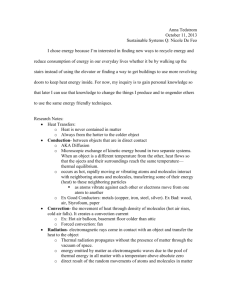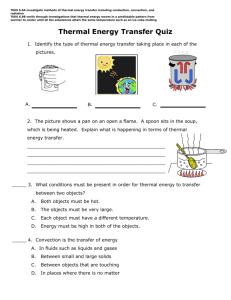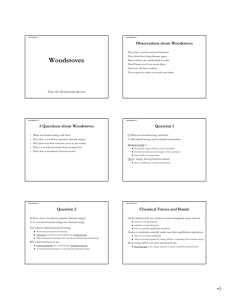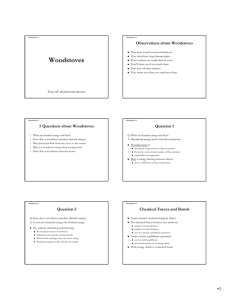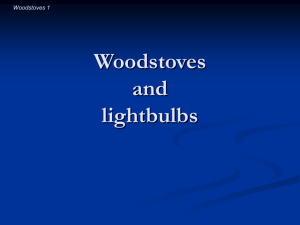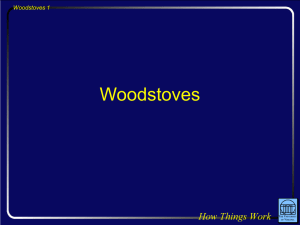Chapter 7 7.1 Woodstoves
advertisement
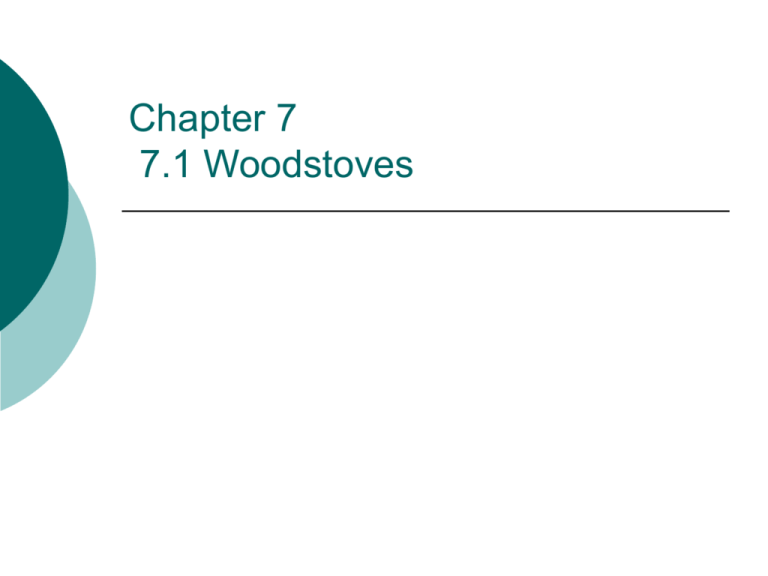
Chapter 7 7.1 Woodstoves Introductory Question A. B. Which is more effective at heating a room: a black woodstove a shiny gold-plated woodstove Observations about Woodstoves They burn wood in enclosed fireboxes They often have long chimney pipes Their surfaces are usually darkly coated They’ll burn you if you touch them Heat rises off their surfaces They warm you when you stand near them 5 Questions about Wood Stoves What are thermal energy and heat? How does a woodstove produce thermal energy? Why does heat flow from the stove to the room? Why is a woodstove better than an open fire? How does a woodstove heat the room? Question 1 What are thermal energy and heat? What is the difference between those two quantities? Can those terms be used interchangeably? Having Thermal Energy Thermal energy is disordered energy within an object, the kinetic and potential energies of its atoms, and is responsible for temperature Thermal energy doesn’t include order energies: kinetic energy of an object moving or rotating potential energy of outside interactions Transferring Heat Heat is energy that flows between objects because of their difference in temperature, or thermal energy on the move Technically, objects don’t contain “heat” Question 2 How does a woodstove produce thermal energy? Burning Wood Fire releases chemical potential energy Wood and air consist of molecules Molecules are bound by chemical bonds When bonds rearrange, they can release energy Burning rearranges bonds and releases energy! Chemical Forces and Bonds Atoms interact via electromagnetic forces The chemical forces between two atoms are attractive at long distances, repulsive at short distances, and zero at a specific equilibrium separation Atoms at the equilibrium separation are in a stable equilibrium and are bound together by an energy deficit A Few Names Molecule: atoms joined by chemical bonds Chemical bond: a chemical-force linkage Bond strength: the work needed to break bond Reactants: starting molecules Products: ending molecules Chemical Reactions Breaking old bonds takes work Forming new bonds does work If new bonds are stronger than the old bonds, chemical potential energy thermal energy Breaking old bonds requires energy reaction requires activation energy to start When Wood Burns… When you ignite wood, the reactants are carbohydrates and oxygen the products are water and carbon dioxide the activation energy comes from a burning match This reaction releases energy as thermal energy Question 3 Why does heat flow from the stove to the room? Heat and Temperature Heat always flows from hotter to colder At thermal equilibrium Microscopically, thermal energy moves both ways But statistically, the net flow is from hotter to colder the temperatures of the objects are equal and no heat flows between those objects Temperature is (approximately) the average thermal kinetic energy per particle Question 4 Why is a woodstove better than an open fire? An Open Fire Burns wood to release thermal energy It has good features: Heat flows from hot fire to cold room But it also has bad features: Smoke enters room Fire uses up room’s oxygen Can set fire to room A Fireplace Burns wood to release thermal energy It has good features: Heat flows from hot fire to cold room Smoke goes mostly up chimney New oxygen enters room through cracks Less likely to set fire on room And it has bad features: Inefficient at transferring heat to room A Woodstove Burns wood to release thermal energy It has good features: Heat flows from hot fire to cold room All the smoke goes up chimney pipe New oxygen enters room through cracks or vents Relatively little fire hazard Transfers heat efficiently to room Heat Exchangers Woodstove is a heat exchanger Separates air used by the fire from room air Transfers heat without transferring smoke Question 5 How does a woodstove heat the room? Heat Transfer Mechanisms Conduction: heat flow through materials Convection: heat flow via moving fluids Radiation: heat flow via light waves All three transfer heat from hot to cold Conduction and Woodstoves Heat flows but atoms don’t In an insulator, In a conductor, adjacent atoms jiggle one another atoms do work and exchange energies on average, heat flows from hot to cold atoms mobile electrons carry heat long distances heat flows quickly from hot to cold spots Conduction moves heat through stove’s walls Convection and Woodstoves Fluid transports heat stored in its atoms Natural buoyancy drives convection Fluid warms up near a hot object Flowing fluid carries thermal energy with it Fluid cools down near a cold object Overall, heat flows from hot to cold Warmed fluid rises away from hot object Cooled fluid descends away from cold object Convection circulates hot air around the room Radiation and Woodstoves Heat flows by electromagnetic waves (radio waves, microwaves, light, …) Wave types depend on temperature cold: radio wave, microwaves, infrared light hot: infrared, visible, and ultraviolet light Higher temperature more radiated heat Black emits and absorbs light best Stefan-Boltzmann Law The amount of heat a surface radiates is power emissivity Stefan-Boltzmann constant temperature4 surface area where emissivity is the measure of emission efficiency Emissivity 0 is perfect inefficiency: white, shiny, or clear 1 is perfect efficiency: black Radiation transfers heat to your skin as light What About Campfires? No conduction, unless you touch hot coals No convection, unless you are above fire Lots of radiation: your face feels hot because radiation reaches it your back feels cold because no radiation reaches it Introductory Question (Revisited) A. B. Which is more effective at heating a room: a black woodstove a shiny gold-plated woodstove Summary about Wood Stoves Use all three heat transfer mechanisms Have tall chimneys for heat exchange Are dark-coated to encourage radiation Are sealed to keep smoke out of room air



